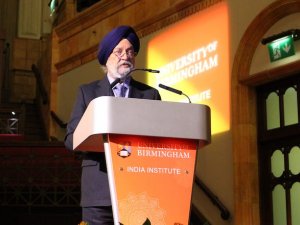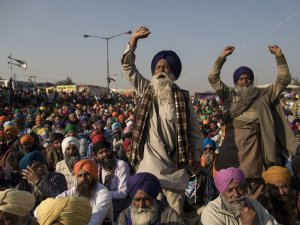Guru Tegh Bahadur (1621-1675) The True Story
(Second Edition published by Sikh Youth Australia)
Guru Tegh Bahadur (1621-1675): The True Story
Second Edition (2021 126 pages
Author: Gurmukh Singh OBE (UK)
Publisher: Sikh Youth Australia
[email protected] : sikhyouthaustralia.co
Book Review by Sardar Tarlochan Singh, Ex-MP & Chairman, National Minorities Commission, India.
We have recently celebrated the 400th birth anniversary of Guru Tegh Bahadur Ji. Due to COVID the expected programmes could not be organised the way we celebrated Guru Nanak Dev Ji 550th Birth Anniversary. We are happy that with the help of the modern techniques seminars and Kirtan Darbars could be organised.
The Sikh Missionary Society U.K. has always been active to produce literature and organise seminars. It is to their credit that the first edition of the popular book “Guru Tegh Bahadur The True Story” was released in 2017. This year, Sikh Youth Australia have released a revised second edition.
The author of the book is S. Gurmukh Singh who has the unique honour of being the first identity Sikh senior Civil Servant to represent the U.K. government department abroad. He was honoured with an OBE award for his meritorious services towards society. I have the pleasure of meeting him and have been continuously reading his articles. I have always found in him rich in intellect, Panthic devotion and writing skill.
I am thankful to him for digging out old records in order to write a true story of the life of Guru Tegh Bahadur Ji and to remove the superfluous tales. The missionaries have been narrating the great powers of our Gurus adding stories full of miracles. From my childhood we have been reading about Guru Nanak’s travels where unnatural happenings were being highlighted only to prove the greatness of our Guru. Much later the Sikh historians produced authentic versions through the books.
While reading the text of the new book I have found that S. Gurmukh Singh has cleared many myths and has written his version based on historical facts. The Sikh community always respect Makhan Shah Lubana and have been giving credit to him to find the ninth Guru. But S. Gurmukh Singh has proved that from Guru Nanak to the 10th Guru there has never been any gap period for succession of the next Guru. Every Gurus in his own lifetime selected His successor and bestowed Gur gaddhi to him. Guru Harkrishan, the only child God in world history, named his own successor-Baba Bakala. The learned author has mentioned in detail that Guru Tegh Bahadur was always called Baba. He has proved that Guru Harkrishan very clearly named him as Ninth Guru. Guru Tegh Bahadur accepted his role and was traditionally honoured by the Sikhs. Similarly, Guru Tegh Bahadur named his son Gobind Rai as tenth Guru before he left Anandpur in 1675 A.D. Makhan Shah Lubhana reached Bakala much later and served the Guru with full devotion for many years.
The author properly explained, with reference to contemporary records, that Guru Tegh Bahadur in his earlier life never spent 20 years just for meditation. He was a trained warrior and was deputed by 7th Guru Har Rai Ji to tour the rural areas of Punjab, for preaching Guru Nanak mission. Guru Tegh Bahadur was the second Guru after Guru Nanak who went to all parts of India as preacher of Guru Nanak mission.
The book further educates us that Guru Tegh Bahadur was arrested three times by the Mughal forces. His last arrest was near Ropar when he left Anandpur Sahib for Delhi after listening to the harrowing tales from Kashmiri Pandits. A detailed account of Guru's detention in Sarhind and other places has been mentioned and also how he was tortured and was kept in an iron cage.
Gurmukh Singh Ji has emphasized how Guru Tegh Bahadur sacrificed his life for the freedom of religion. Guru Ji never agreed to conversion under allurement or threat. Guru Ji wanted that everyone can choose his way of worship and there should be freedom of conscience. The book proves that Mughal Emperor Aurangzeb was in Delhi and issued the order of execution of Guru Tegh Bahadur. Aurangzeb could not tolerate anyone who was a defender of religious freedom.
Here I may add that during my speeches in the Indian Parliament I narrated the atrocities committed by Mughal Emperors Babar Jahangir and Aurangzeb. Guru Nanak in his Bani has mentioned that Babbar was responsible for creating terror and bloodshed and killing the innocent people. Emperor Jahangir issued the order for the martyrdom of Guru Arjun Dev Ji. Aurangzeb put his father in prison, killed his brother and ousted his sister and wanted entire India to be converted to Islam.
This book has also cleared another doubt regarding the role of Baba Ram Rai, son of Guru Har Rai, who was earlier ousted for wrong quoting of Gurbani. It is now written that Guru Tegh Bahadur met Baba Ram Rai in Delhi on 21st March 1664. Secondly the book has come out with another positive historical fact that when Guru Harkrishan Ji met emperor Aurangzeb Baba Ram Rai ji accompanied him. A detailed dialogue by Baba Ram Rai Ji is quoted on the basis of new findings from Bhat Vahi Poorbi – Dakhni.
Earlier I read that Guru Gobind Singh met the wife of Baba Ram Rai Ji at Paonta Sahib. I remember Gyani Zail Singh, Chief Minister of Punjab, went to Dera Baba Ram Rai in 1974 and was highly impressed that holy artifacts were properly maintained. He had at that time advocated that there should be reconciliation of the Sikhs and the Dera. I, as Chairman National Minority Commission, was able to get a huge financial grant from the Culture Ministry Government of India for conservation of the paintings, artifacts and the building of the historic dera.
The book has condemned the role of Mullahs and Brahmins in eastern India who were unhappy with the preaching of Guru Tegh Bahadur. This was very natural because Guru Nanak and all other Sikh Gurus were against the rituals being performed by the pujaris at all religious places. This resulted in the loss of the income and popularity of all of them. Guru Nanak visit of Haridwar is a big testimony to this as he started throwing water to the opposite direction which annoyed the Hindu pujaris. We must realize that Aurangzeb was a dictator and from day one he decided to spread Islam through oppression. Even Jahangir in his autobiography-Tuzke Jahangiri has mentioned that he ordered the execution of Guru Arjun. We have been putting the entire blame on Chandu. The Muslim historians have always highlighted the Mughal emperors as benefactors of people and this distorted the history. They have never criticized the anti-Hindu role of the Muslim Kingdom.
I hope the book will be properly received by all of us and everyone should present it as a gift to their friends. The Sikhs at large should adopt book reading habits so that we may encourage authors to enrich the Sikh literature.
The book can be located on and downloaded free of charge from Sikh Youth Australia Website: http://www.sikhyouthaustralia.com
Tarlochan Singh
Ex-Member of Parliament & Chairman National Minorities Commission
New Delhi
28 August 2021
E-mail: [email protected]
~~~~~~~~~~~~~~~~~~~~~~~~~~~~~~~~~~~~~~~~~~~
Related article:






